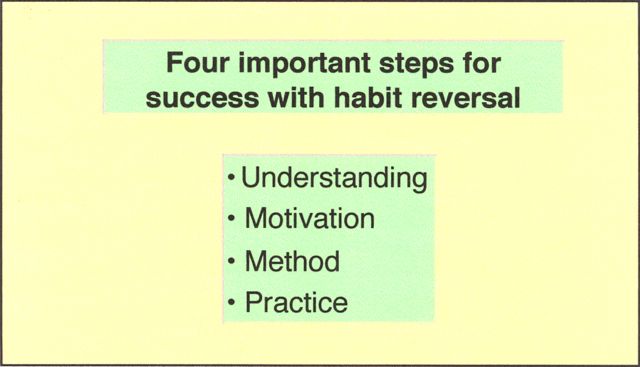Habit Reversal Tip #15 Essentials for habit reversal success

Whether you are using habit reversal on your own, or with a practitioner in a clinic, knowing the essentials for success will help, especially if things do not seem to be happening as expected.
Experience shows that there are four important steps to take. If things do not then change as planned, it's worth reviewing each in turn:
- Understanding
Understanding a habit, and the effect it is having, sounds a simple place to start, but it may not be. Always go back to this if problems with habit reversal are encountered.
With habitual scratching and atopic eczema, it is important to know how regular scratching affects the skin, how regular scratching becomes a habit, and how habits can link with circumstances and activities, other than the original trigger: itching!
The better the ramifications of a habit are understood, the better the outcome with habit reversal. An ABC analysis of behaviour can help:
- Antecedents:
what happens before the behaviour?
- Behaviour:
what constitutes the behaviour?
- Consequences:
what follows the behaviour?
Try writing these out, and add to them after further thought, and perhaps after talking about them with someone else.
- Motivation
Wanting to change things is crucial, but motivation too can be complicated.
Patterns of problem behaviour that have become habitual can be influenced by various entrenched conflicting attitudes and beliefs, including those that involve others. These factors may not be immediately obvious, but may need exposure and direct confrontation if they are to be overcome.
Fortunately a matter-of-fact anticipatory review of the clear personal benefits of successful habit reversal is generally sufficient to motivate effective practice of the method, with the positive consequences reinforcing a new set of optimistic expectations about treatment.
- Method
Having a method or technique available seems particularly important at first sight, but with habit reversal it is relatively easy, compared with the other three steps in this list. Certainly a method is essential - but habit reversal is there to be used, or not, as the case may be. It is tried and tested, it is not difficult, it is not time-consuming, and it really works!
- Practice
Once everything is in place - understanding, motivation and method - the only thing that is needed is regular practice, coupled with monitoring of progress, and of course troubleshooting if things do not seem to be happening as expected.
Which is where we started....
NEXT SEE...
- Key elements in habit reversal
- Coping with difficulties: Adults and Older Children
- Coping with difficulties: Younger Children and their Parents
